The Tarot Garden of Niki De Saint Phalle
an esoteric garden in Maremma by guest contributor novelist Linda Lappin
I am honored to introduce this month’s guest contributor: my good friend and neighbor, Linda Lappin. Linda is a well known author and writing teacher with a strong sense of place. Her exhaustive website www.lindalappin.net gives information about her books and happenings as well as inspiration for writers and those who aspire to become writers.
——————-
Along the Via Aurelia near the exit for Capalbio - there on the scrubby Maremma hillside, a kaleidoscopic flash of color-red, green, turquoise, yellow, hot pink bedazzles your eyes. Further on, bizarre shapes pop out from the silvery blur of olive groves as you drive by: the pointy tip of a red rocket, a huge turquoise face with stairs spilling out of its gaping mouth, a giant rooster with a spikey cockscomb, a sparkling tower with its roof cracked open and a bicycle wrreck on the top.
It looks as though some psychedelic circus with crazy carnival rides has just set up camp on the hill. Instead, its a monumental sculpture garden-the Tarot Garden-the major oeuvre of French-American artist Niki de Saint Phalle.
entering the Tarot Garden - il Giardino dei Tarocchi
The Tarot Garden occupies a special place in Saint Phalle’s artistic journey. Construction first began on the project in 1979 when she was forty-nine years old, although the idea for the garden stretches back to 1955. The garden took nearly twenty years to complete, opening to the public in 1998 when Saint Phalle was sixty-eight. Her second husband, Jean Tinguely, her artistic partner who had assisted her by welding the steel skeletons for all the structures and creating several pieces of his own for it, had already passed in 1991. Saint Phalle followed him in 2002.
a young Niki
Daughter of a French aristocrat and an American heiress, Niki de Saint Phalle was born Catherine Marie-Agnes Fal de Saint-Phalle in Neuilly-sur-Seine, France. Shortly after her birth, her parents emigrated to the United States leaving Niki with her grandmother in the grandiose family chateau. Its stonework, secret places, coats-of-arms and heraldic symbols made a powerful impression on her further enhanced through the years by the stories her grandparents told her: fairy tales, legends of knights and ladies, and the illustrious history of her ancestors. It was an environment presided over by a nurturing mother figure-her grandmother- and an enchanted place where fantasy may become real. Her hunger for magic places would become a driving force in her artistic development.
one of the garden’s weird, wonderful sculptures
At the age of three she joined her parents in New York City where they had settled on the Upper East Side. Her father financed the most famous restaurant in the city Le Pavilion where they often dined. Her mother made sure her children benefited from the city’s many cultural opportunities, museums on Sundays, ice skating at Rockefeller Center, summers in Connecticut or visits to France and the family chateau.
Though this might sound ideal, Niki’s childhood and adolescence were turbulent and traumatic. Both parents were abusive. Despite all, Niki adored her sophisticated, elegant mother and craved her good opinion, rarely granted. As an adult she believed that this was the key to her success as an artist. Learning to survive emotionally without her mother’s approval made her independent and free from the judgements of others. Rebellious and mischievous, she did poorly at school. Strikingly beautiful, she found work as a fashion model at the age of seventeen and at eighteen escaped her nightmarish family by eloping with the writer-musician Harry Matthews.
Just a year older than Niki, Harry came from a wealthy family gravitating in the Saint Phalles’ elite circle. In Barcelona, Saint Phalle visited Gaudi’s Park Guelll for the first time. It was her meeting with a master, an experience so overwhelming that it made her tremble with a sense of destiny. “I knew someday I would make my own Garden of Joy,” she wrote.
She had dreamed of creating her own garden for years, seeking the right spot, which she thought might be Africa or South America. By chance or fate, the chosen spot turned out to be a former quarry in the Tuscan Maremma. The land belonged to the Caracciolo brothers, whose sister, Marella, wife of Gianni Agnelli, happened to be a close friend. Niki swept into Garavicchio, the Caracciolos’ village, like a whirlwind wearing a polka dot dress and a straw hat decorated with a flock of birds. Showing them a tiny clay model of the sculptures she envioned, she demanded, “I need a piece of your land to build a park based on the Tarot cards.”
The area they selected was enclosed by rocky cliffs forming a sort of amphitheatre, which had once been used by the Etruscans as a burial site. There could have been no better place than here in Maremma, near the province of Viterbo where several of Italy’s greatest esoteric gardens are located: Villa Lante, the Sacred Grove (aka the Park of Monsters) of Bomarzo, the gardens of Villa Farnese in Caprarola.
By placing her garden here, Saint Phalle had connected up with the local tradition of landscape narratives and healing gardens. In the sixteenth century mannerist tradition, those gardens were to be “read” with the heart and mind as much as they were to be enjoyed with the senses. The placement of fountains, trees and sculptures obeyed a narrative strategy that might revel a secret doctrine, heal an illness, enhance political power, lead the way to spiritual enlightenment, or simply alter fate.
tarot garden fountain
Such gardens were magic books hewn in stone, in which the visitor while wandering about, became the actant or performer of an ever-changing story, a necessary element in the garden’s magic. For Saint Phalle, the Tarot Garden was a corner of paradise achieved through an inner itinerary of sacrifice and spiritual growth. She wanted to capture the essence of each arcanum as she had personally experienced it.
The monumental sculptures were built by first welding a steel framework for each piece, covering it with mesh wire, and then spraying it with concrete to create gigantic, grey somber forms. Next the sculptures were covered with brightly colored ceramic tiles, glass and mirror fragments. The glass mosaics were brought from Venice and the ceramic tiles made locally, many designed and produced by the Italian ceramic sculptor, Venera Finocchiaro.
a mosaic tower
Niki de Saint Phalle personally financed and built her Tarot Garden costing at the time five million dollars, although she was helped by fellow artists, workmen, friends, local people, lovers, admirers and enthusiasts. To raise funds for the garden she created a perfume which became an international success. Friends also chipped in, bringing suitcases full of cash. She also created and marketed a line of Nana-shaped pool toys
the horse sculpture
Along the way she encountered many obstacles, including illness. Severe rheumatoid arthritis disabled her from working on the garden for long periods. She developed lung disease from using the polyester resin. She also struggled at first with the fervent opposition of local residents who objected to her project calling her sculpture “Monsters”. When bureaucratic snares developed over the lack of building permits, a white knight appeared, as in all fairy tales, to rescue what is good and true: Francois Mitterand, a great admirer of her work, saved the garden from Italian red tape more than once.
kitchen inside a monumental sculpture
Paths seem random through the Garden, and, at Saint Phalle’s request, there are no guided tours. The point of this garden is to discover it yourself, and while doing so, discover yourself.


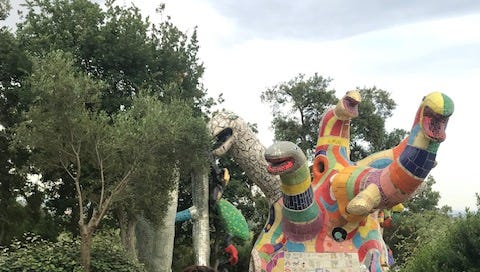


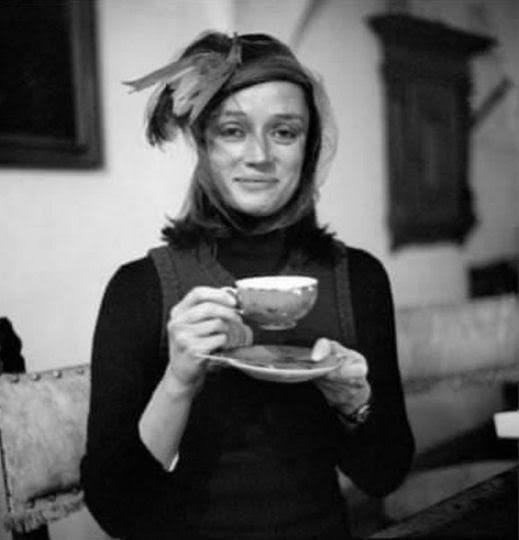
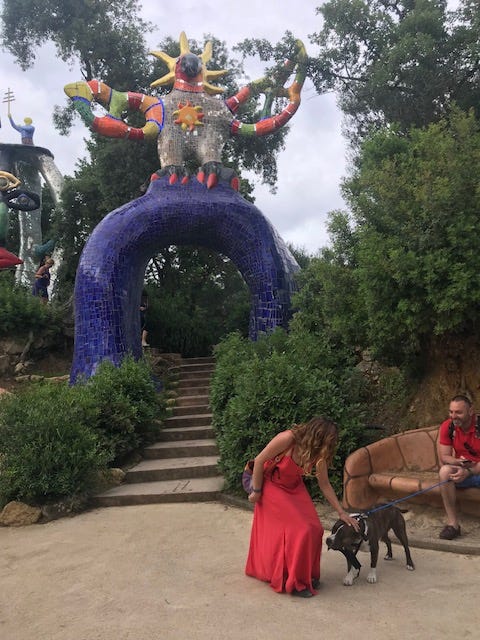

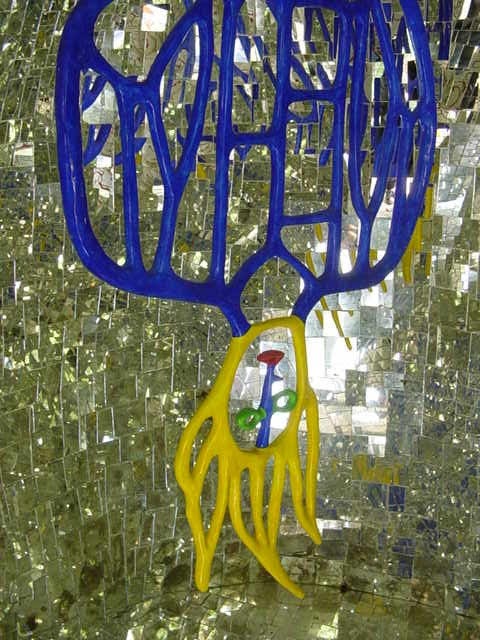
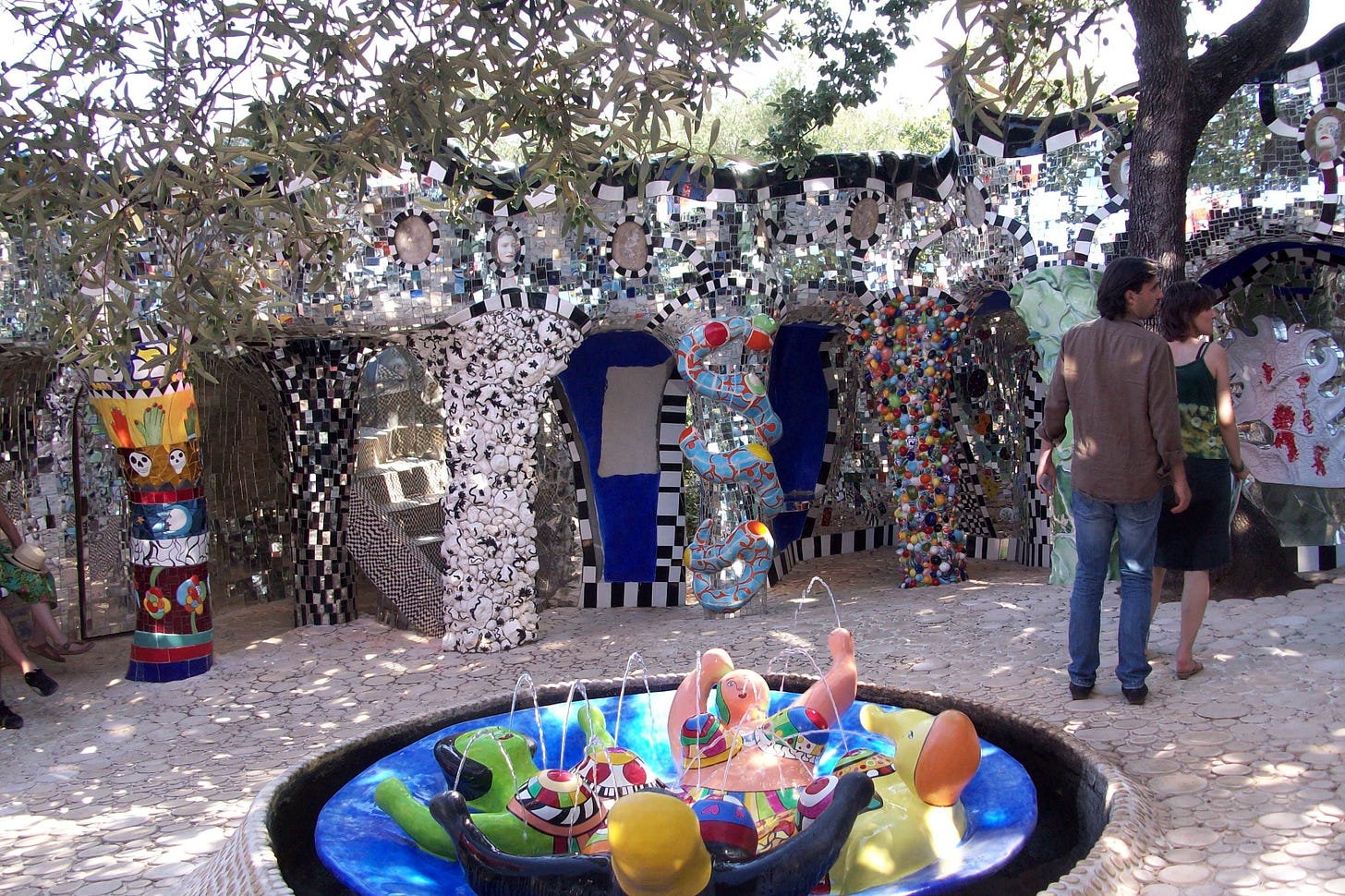
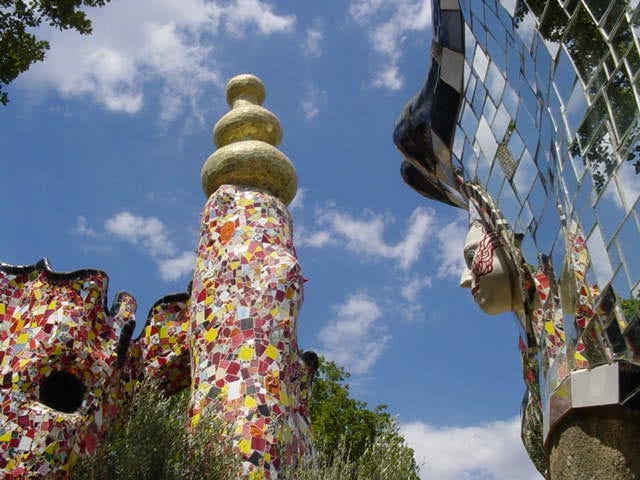
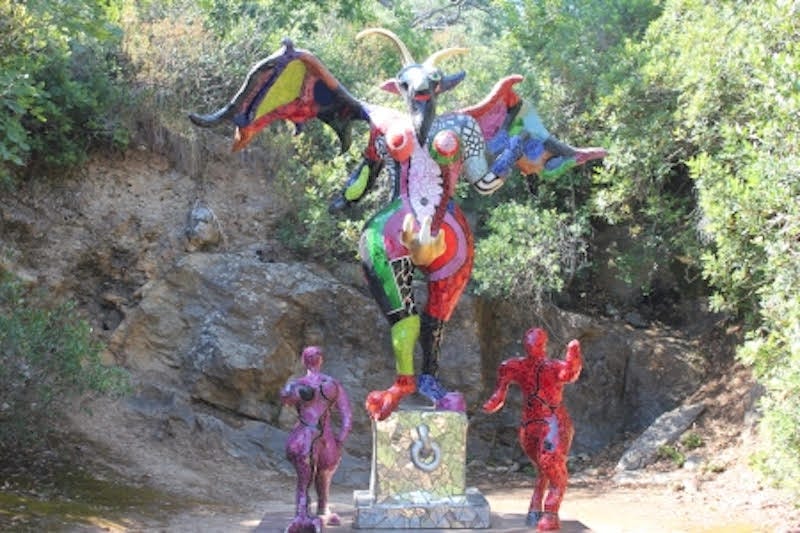
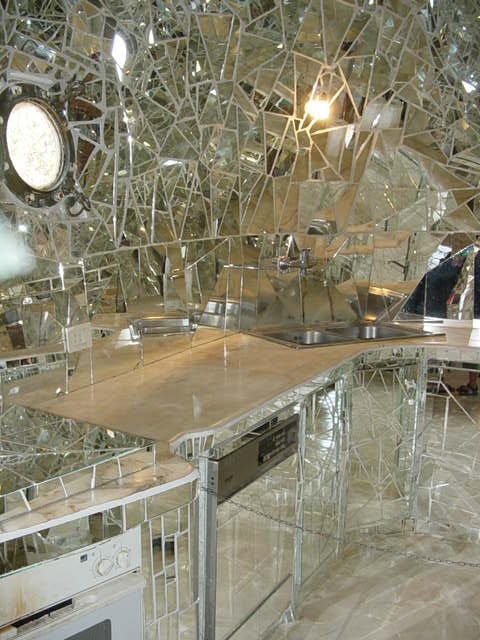
"the horse sculpture" is mislabeled. The arcanum portrayed is actually THE DEVIL.
The mosaic tower is also the arcanum of the Emperor - symbol of male energy.
De Saint Phalle studied the Tarot for years and developed her own vision of the major arcana. Some of the sculptures are based on traditional iconography, while others were entirely her own interpretation. In my blog https://magiclibrarybomarzo.wordpress.com/2024/04/05/the-tarot-garden-of-niki-de-saint-phalle-2/ from which this article is abridged, I compare some of the traditional depictions with De Saint Phalle's interpretations -- LL
It’s a very interesting garden and can be enjoyed and understood at many different levels; like the Sacro Bosco of Bomarzo. I encourage readers to go to Linda’s magic library blog to get a deeper explanation of the Tarot and when in this area stop by Cinzia Chiulli’s shop of tarot and ceramics in the medieval quarter of San Pellegrino in Viterbo. So many layers, so many arcane things are available when you travel and/or live in Italy.